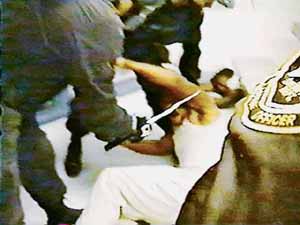


|
|
1996 assault on prisoner at Brazoria County jail, Texas. Scene was taped as part of a training video for prison guards. In Illinois, Pennsylvania, Virginia and other states similar practices are rampant, but are virtually never documented through photos.
|
The report, titled The New Landscape of Imprisonment: Mapping America’s Prison Expansion, was released by the Urban Institute in April. The study focused on the changes in the last 25 years in the 10 states with the largest prison increases—California, Colorado, Florida, Georgia, Illinois, Michigan, Missouri, New York, Ohio, and Texas. Entire communities are now dependent economically on the mushrooming prisons.
The construction boom is fueled by the sharp and continuing rise in incarceration. Between 1980 and 2002 the number of those held in state or federal prisons, as well as local and county jails, increased from just over half a million to 2,033,000. People behind bars, on parole, or on probation more than tripled over the same period to 6.7 million.
Recent reports by Reuters and other media, based in part on facts provided by the Sentencing Project, a research and advocacy group based in Washington, D.C., show that during this time physical abuse and degradation of inmates by prison guards has been widespread. In addition to beatings, this has included routine stripping of prisoners in front of other inmates before moving them to another prison and forcing newly arrived inmates to wear black hoods.
In the states with the largest prison increases, the New Landscape of Imprisonment study reveals that one-third of all counties have at least one prison—an increase from 13 percent in 1979. Across the nation, the number of state prisons alone grew from 592 in 1979 to 1,023 in the year 2000.
Florida tops the list with a state or federal prison in more than three-quarters of all counties. Next were California and New York, with 59 percent and 52 percent, respectively.
Texas led the way nationwide in building new jails. In 2000 the state had 137 prisons, seven times the 1979 figure and 50 percent more than Florida and California, the next highest.
While the majority of new prisons built over the period studied were in metropolitan areas, the four-fold increase in the prison population as a whole has meant that in some rural counties, prisoners now make up a significant proportion of the overall population. Each of the 10 states has at least five counties where prisoners make up 5 percent or more of the total residents. In Concho County, Texas, prisoners make up 33 percent of the population of 4,000. While 5 percent of the population in the 10 states lives in rural areas, 23 percent of the prison population is locked up there.
The government includes the number of prisoners in the census for determining the total population of an area and its number of elected representatives—even though prisoners are stripped of their voting rights.
The report also notes that inmates are more and more frequently forced to serve their sentences far from their home counties. In Georgia, Ohio, Texas, Florida, and California only four out of a total of 626 counties had a high proportion of prisoners from the local area.
Systematic abuse
According to the Sentencing Project, during the 25-year prison boom 40 state prison systems were under some form of court order for brutality, overcrowding, poor food, or lack of medical care.
Methods of torture and human degradations like those recently revealed in Iraq (see front-page article) have been rampant in U.S. jails, according to a May 8 report by Reuters and another one the same day in the New York Times. Both cite corrections officials, inmates, and human rights advocates as their sources.
While the articles cite poor training and difficulty hiring prison guards to keep pace with the expanding prison population as reasons for the brutal conditions, the sheer scope of the evidence cited shows that abuse and degradation of workers and farmers behind bars is an integral part the capitalist “justice” system at home and abroad.
Some of the other examples cited in the articles include: